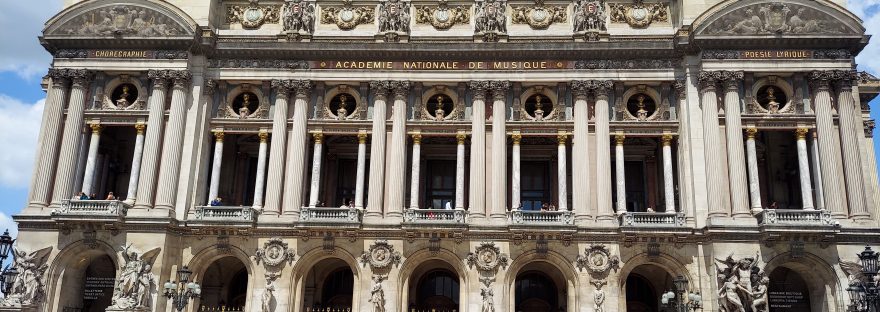As part of the urban transformation proposed by Napoleon III in Paris during the Second Empire, the “Opéra Garnier”, also known as the “Palais Garnier” or Paris Opera, was built. The emperor intended the new opera house to be the symbol of the new Paris.
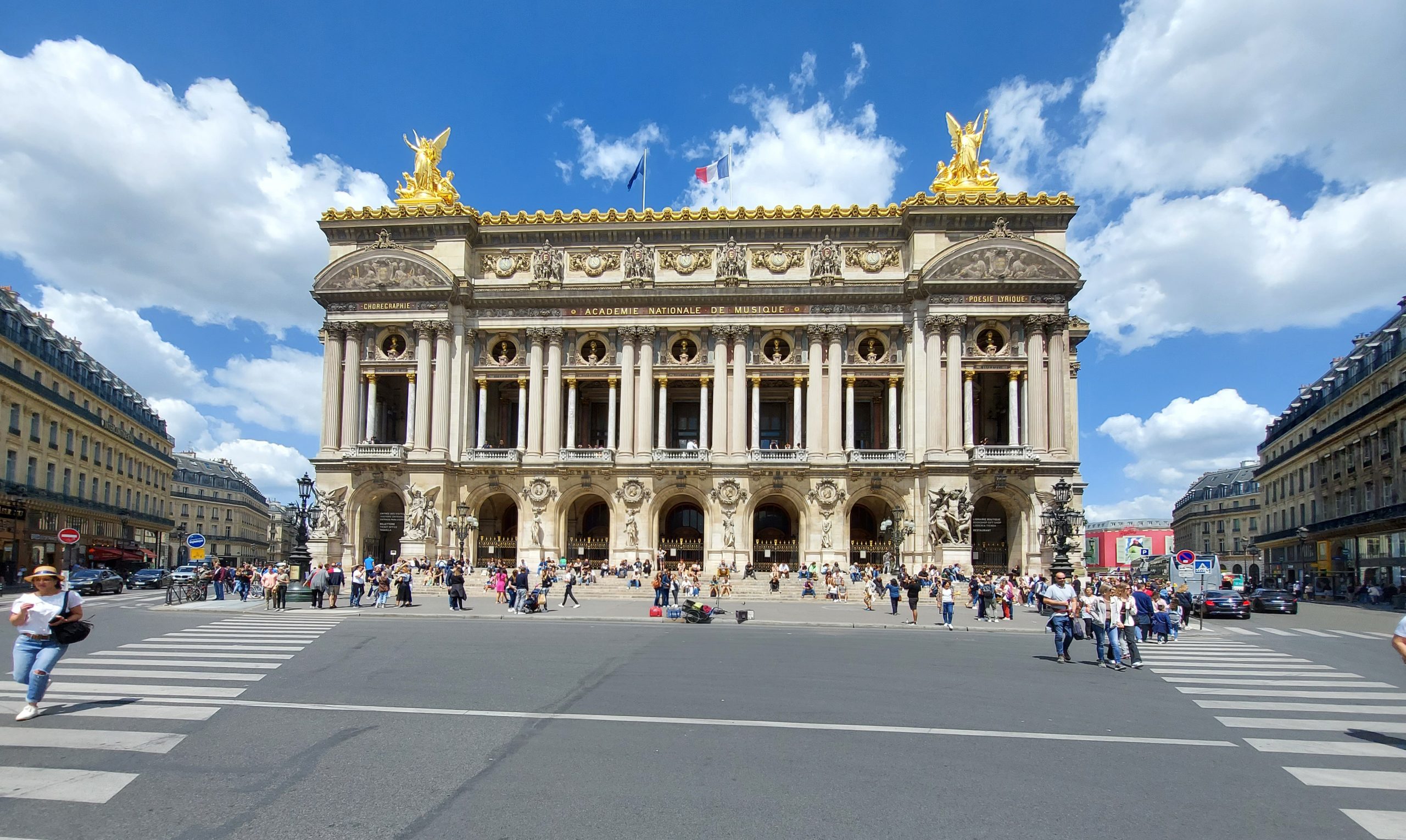
It was through a competition in 1861, that the project was awarded to the young architect Charles Garnier (1825-1898), starting the works in 1862. A curious fact that is often mentioned is that it is said that the wife of Napoleon III, the Empress Eugénie de Montijo, asked Garnier during the construction, if the building would have Greek or Roman style, to which the architect replied: “It is in Napoleon III style, madam!”. Although, many categorize the style of the Garnier Palace, as Neo-Baroque, where French Baroque and Italian Baroque meet.
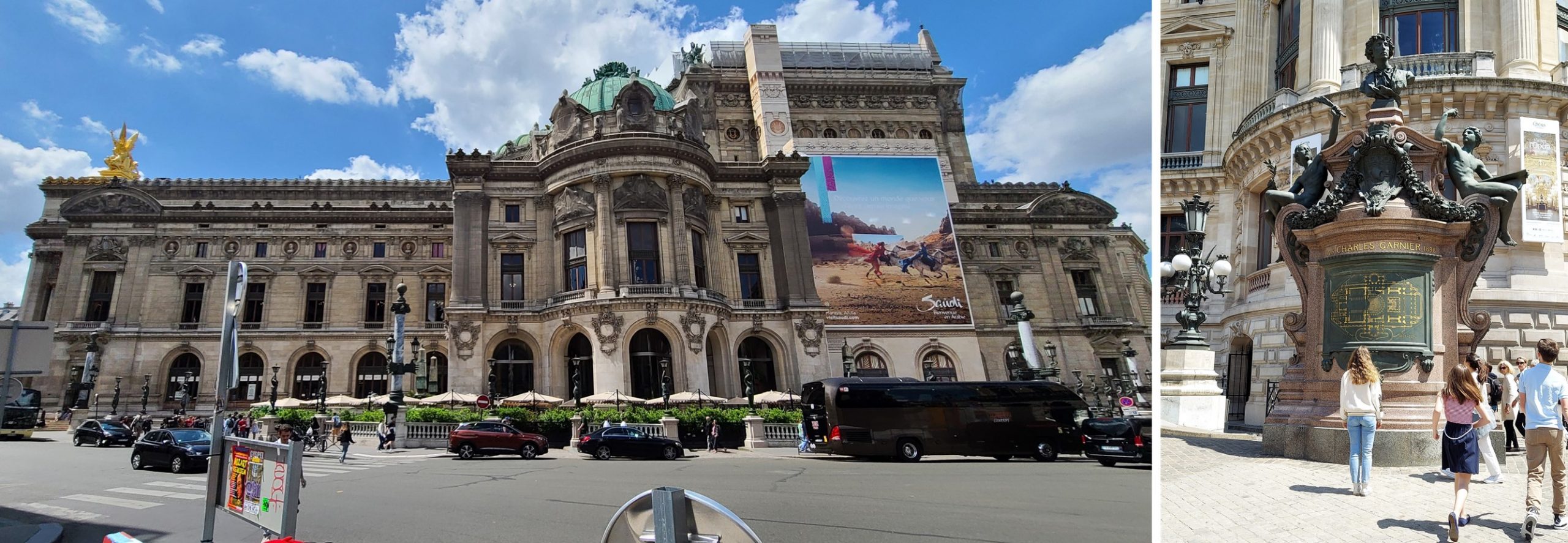
The construction of the Opera suffered several setbacks. From finding subterranean waterways during excavations, the ravages of the Franco-Prussian war, the fall of the Second French Empire and the Paris Commune of 1870. Not only these setbacks delayed the work, but also the threat of disappearing. And, as sometimes happens, a tragedy becomes the solution and the salvation of a situation. Thus it was that an opportunity arose to finish the work on the Palais Garnier, after the destruction in 1873, due to a devastating fire, of the former Paris Opera House, known as the “Théâtre de l’Académie Royale de la Musique”. This theater had been the home of Parisian opera and ballet since 1821, where the greatest masterpieces had been presented, and was the venue where romantic ballet reached its apogee.
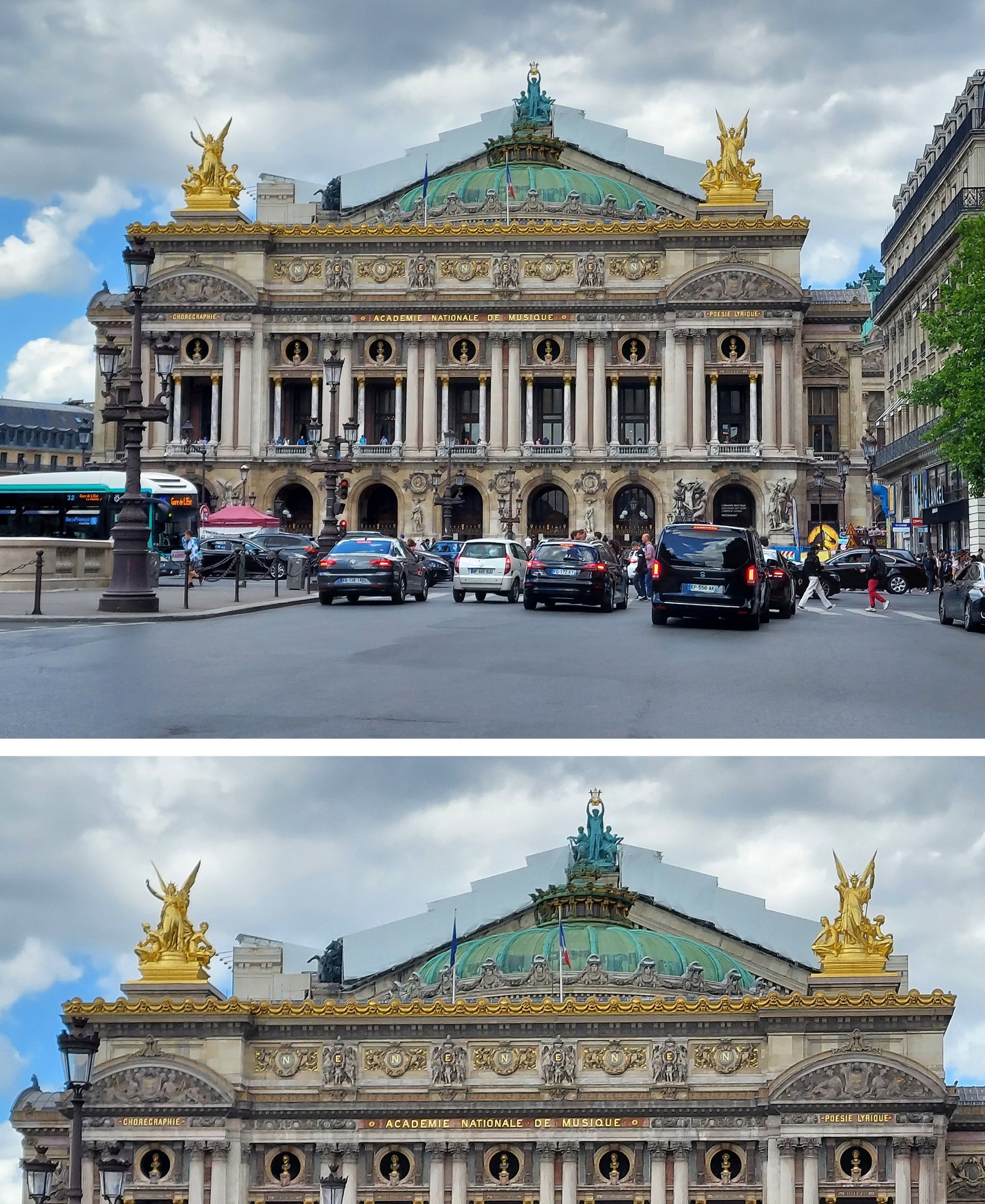
The facade of the Palais Garnier should be carefully observed from afar, and thus appreciated in detail. It is topped with an attic that reminds us of a crown, displaying a sculptural ensemble composed of Apollo with poetry and music, the two arts that make up the opera.
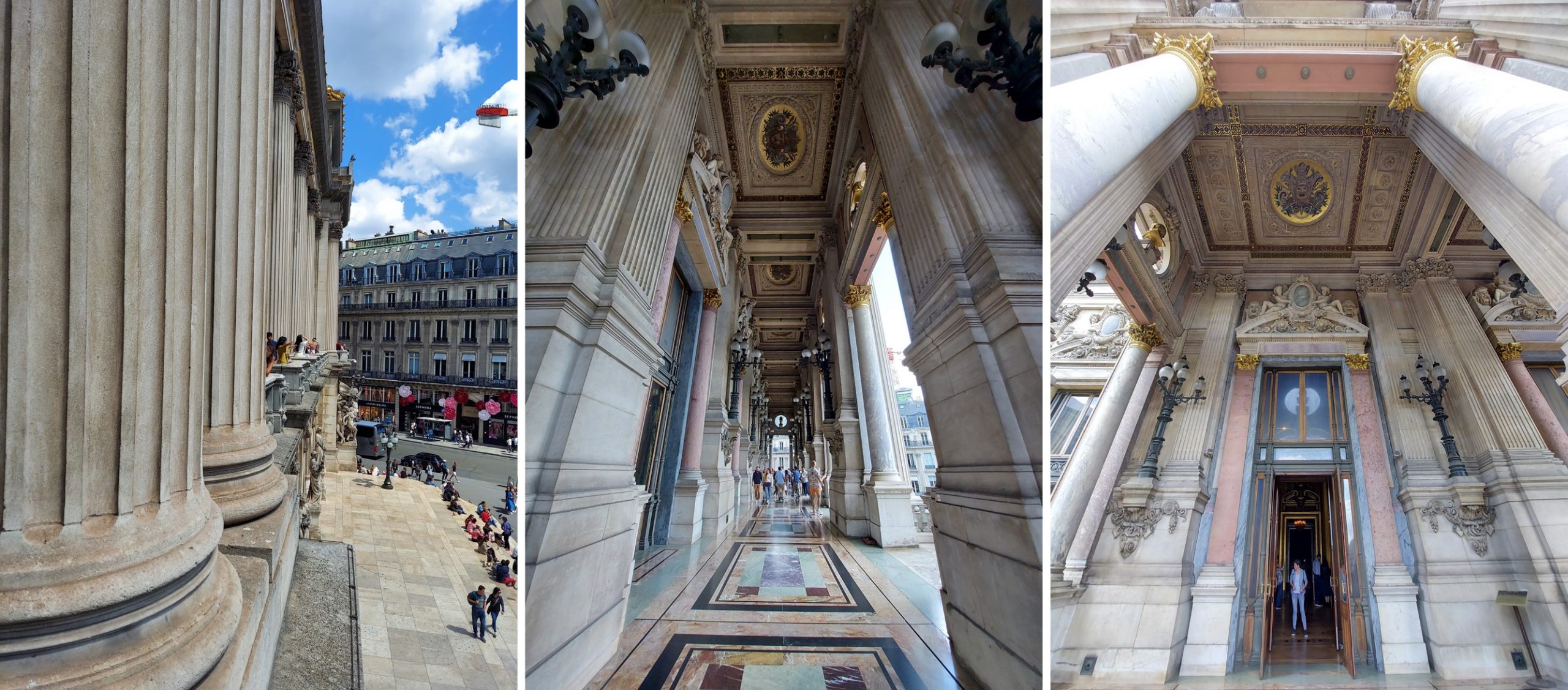
The facade of the Palais Garnier is distinguished by its arches in the lower part and its columns, some more monumental than others. And on the sides are shown the two special entrance pavilions, one for the emperor and the other for patrons.
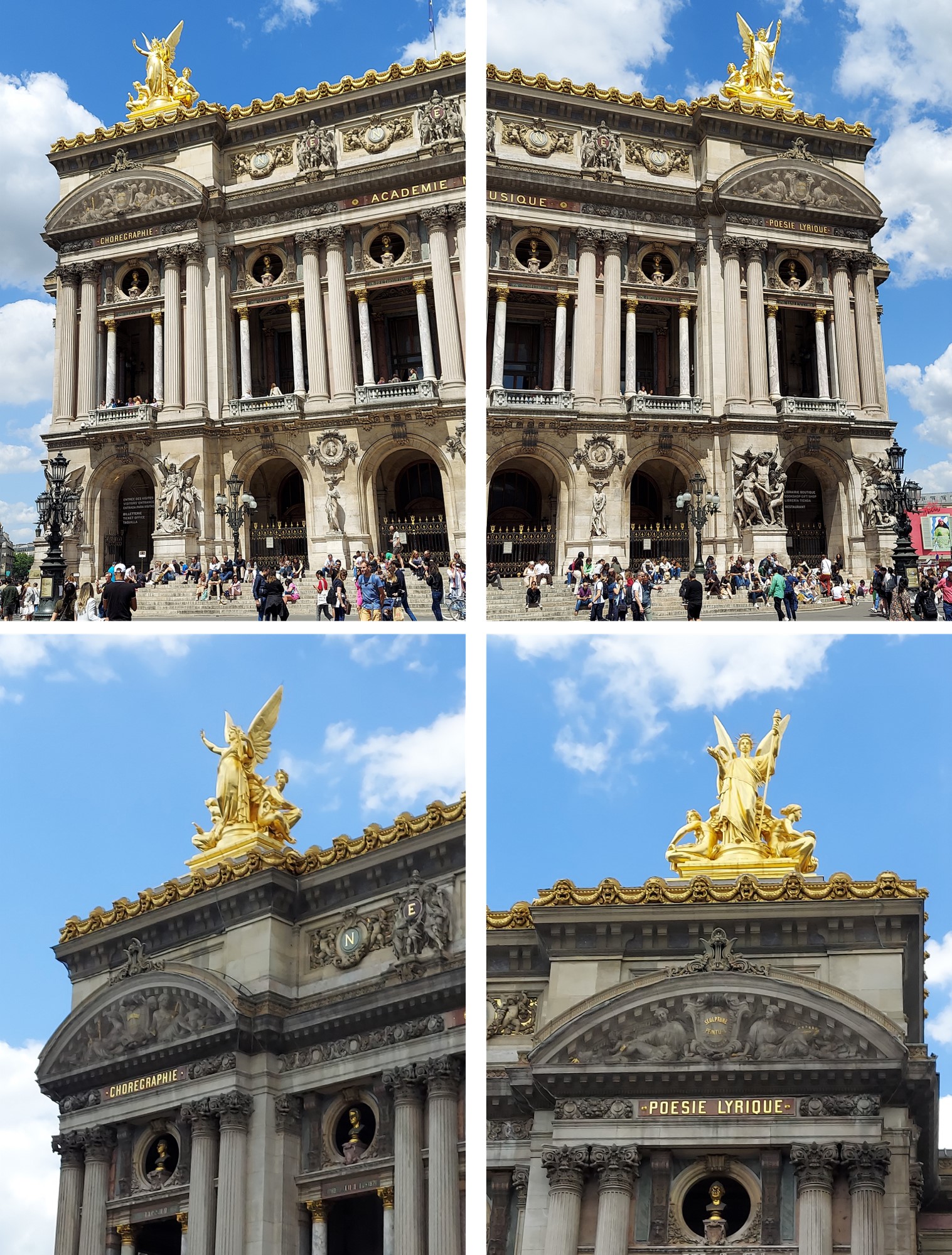
In addition, the golden statues symbolizing poetry, music, dance and lyric are dazzling and the busts of those composers who brought music to the Opéra Garnier add a well-balanced decorative element to the façade.
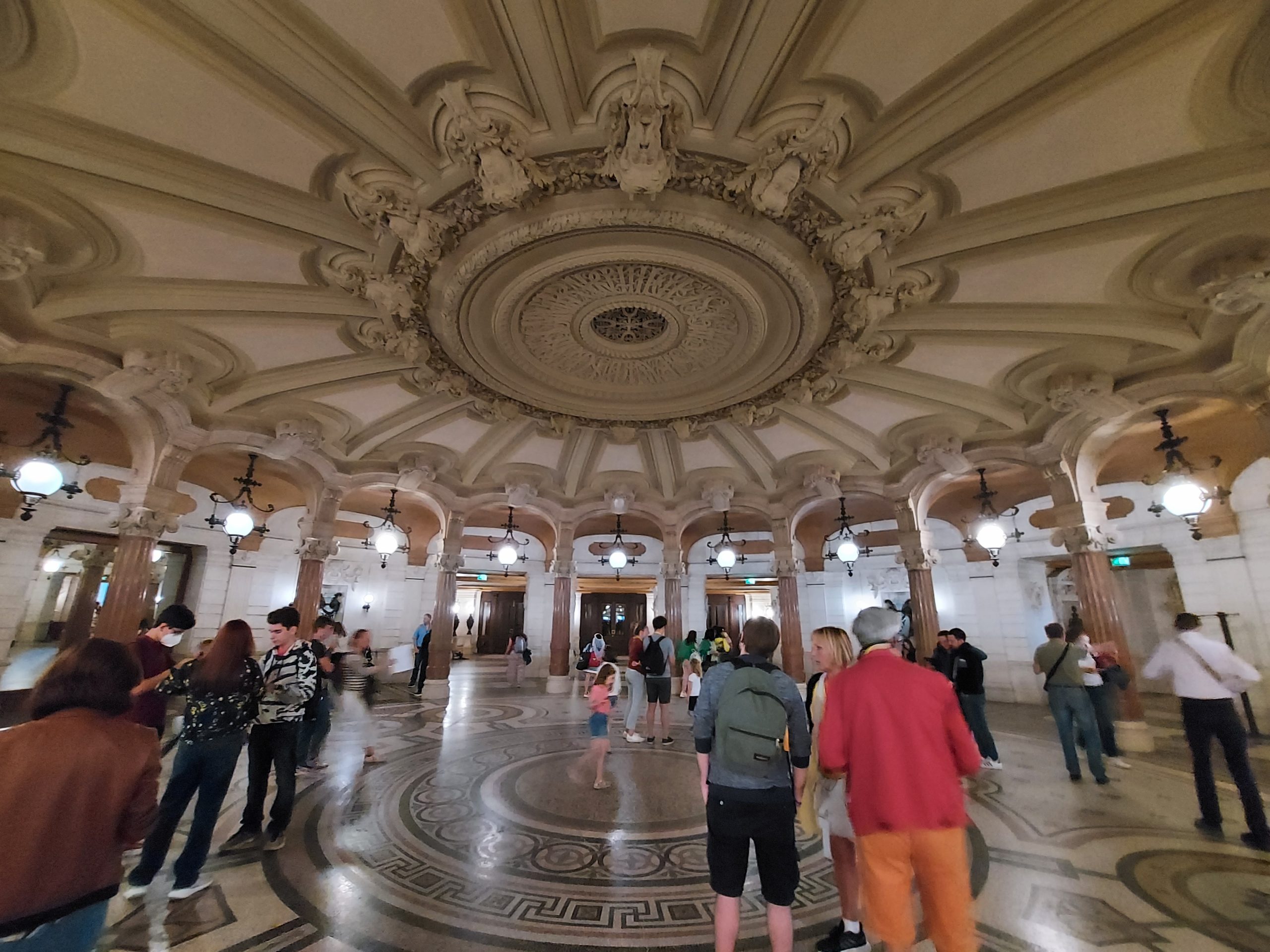
This circular hall, called the Patron’s Rotunda, located just below the auditorium, was used to welcome spectators or patrons arriving by car. Hence its name, it was the entrance hall for those who had rented boxes all year round. The floor is adorned with magnificent marble mosaics.
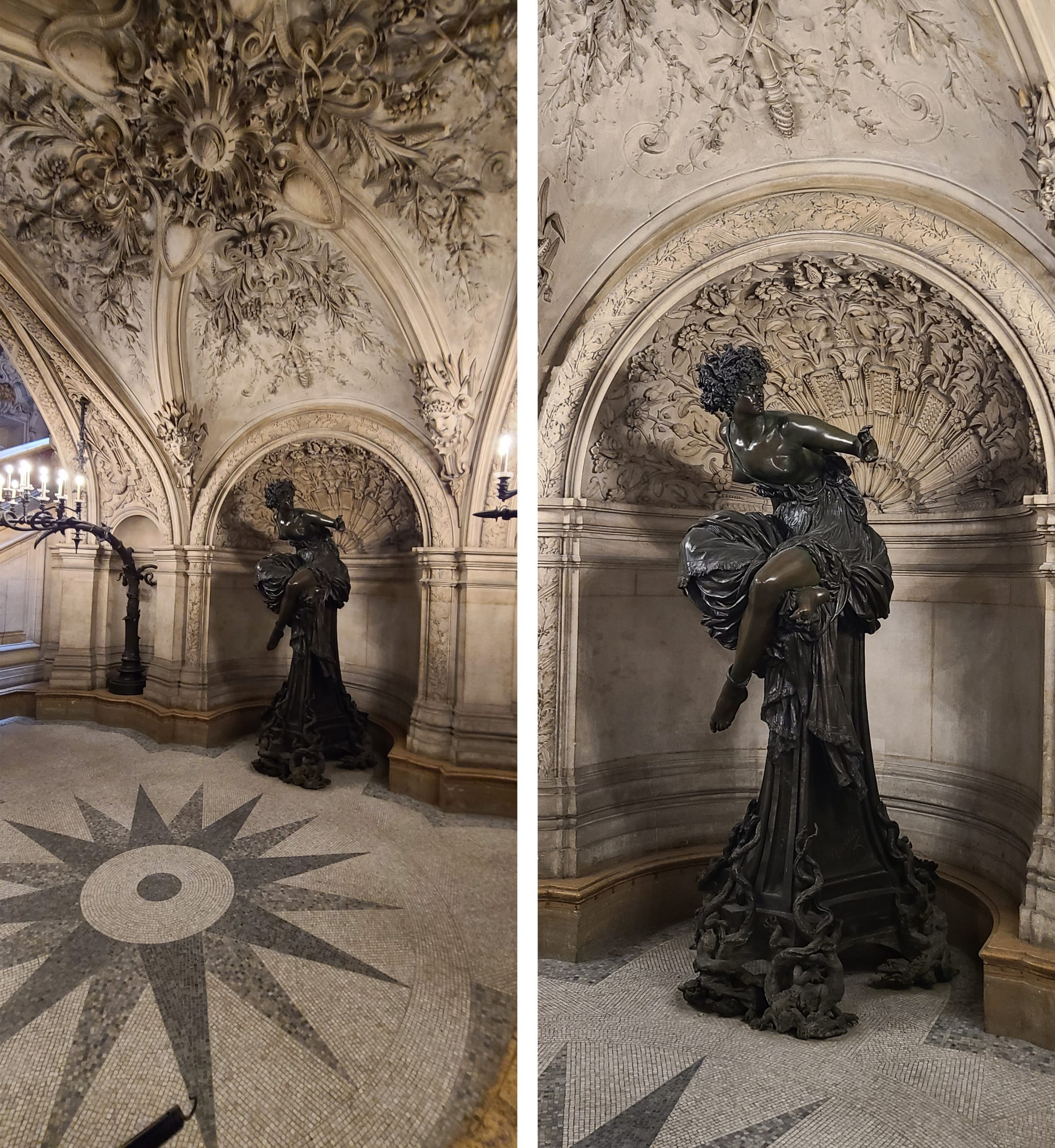
In the central axis of the Rotunda is “La Pythonisse”. In Greek mythology, “Pythie” was the priestess of Apollo, symbolizing through this mythological figure the strength, influence and nobility of the lyrical Art, that is to say, to show on stage the destiny of men.
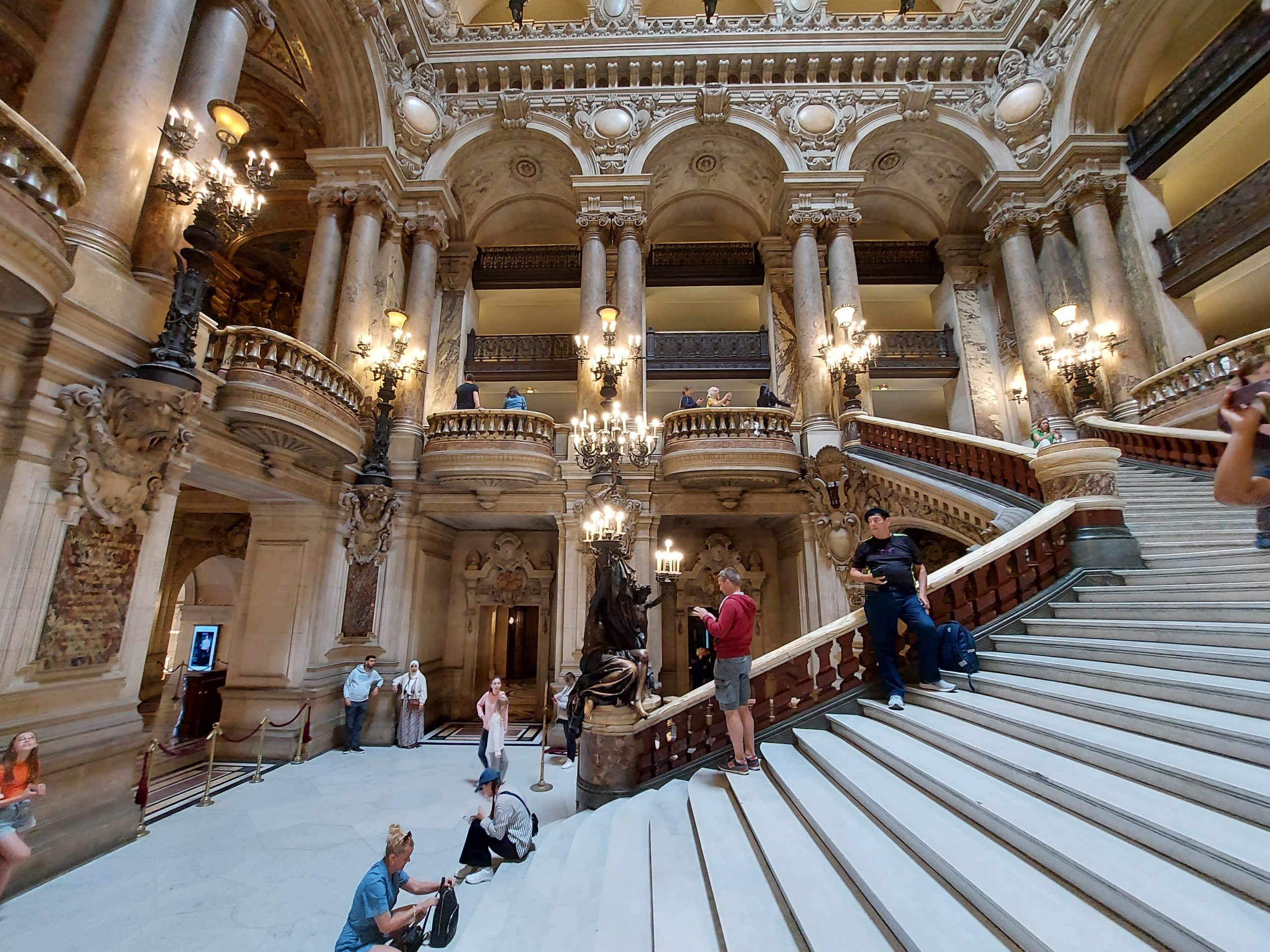
As soon as you reach the grand staircase, it is inevitable to think of all those movies showing extravagant parties, full of ladies with their elaborate wigs and sumptuous dresses, accompanied by their knights, all of noble lineage.
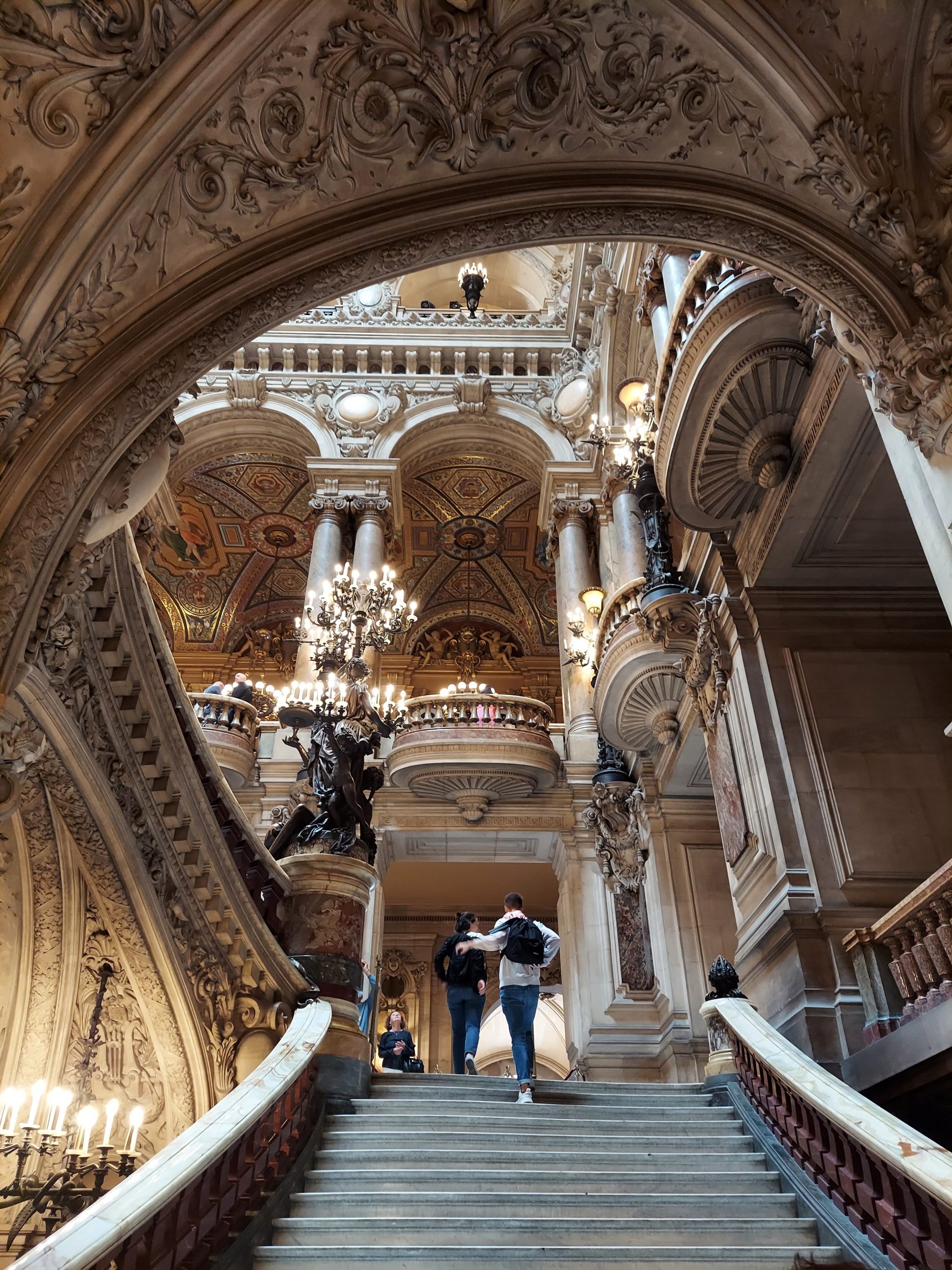
Climbing the grand stairs that link the two levels is quite an experience. In fact, as Garnier himself said, stating that it was this staircase his great work within the palace:
“The Opera is the stairway, just as the Invalides is the dome and Saint-Etienne-du-Mont is the pulpit. I have no complaints whatsoever about this condensation at one point, which can suffice to cover an architect with glory, just as winning a battle can suffice to cover a general with glory.”
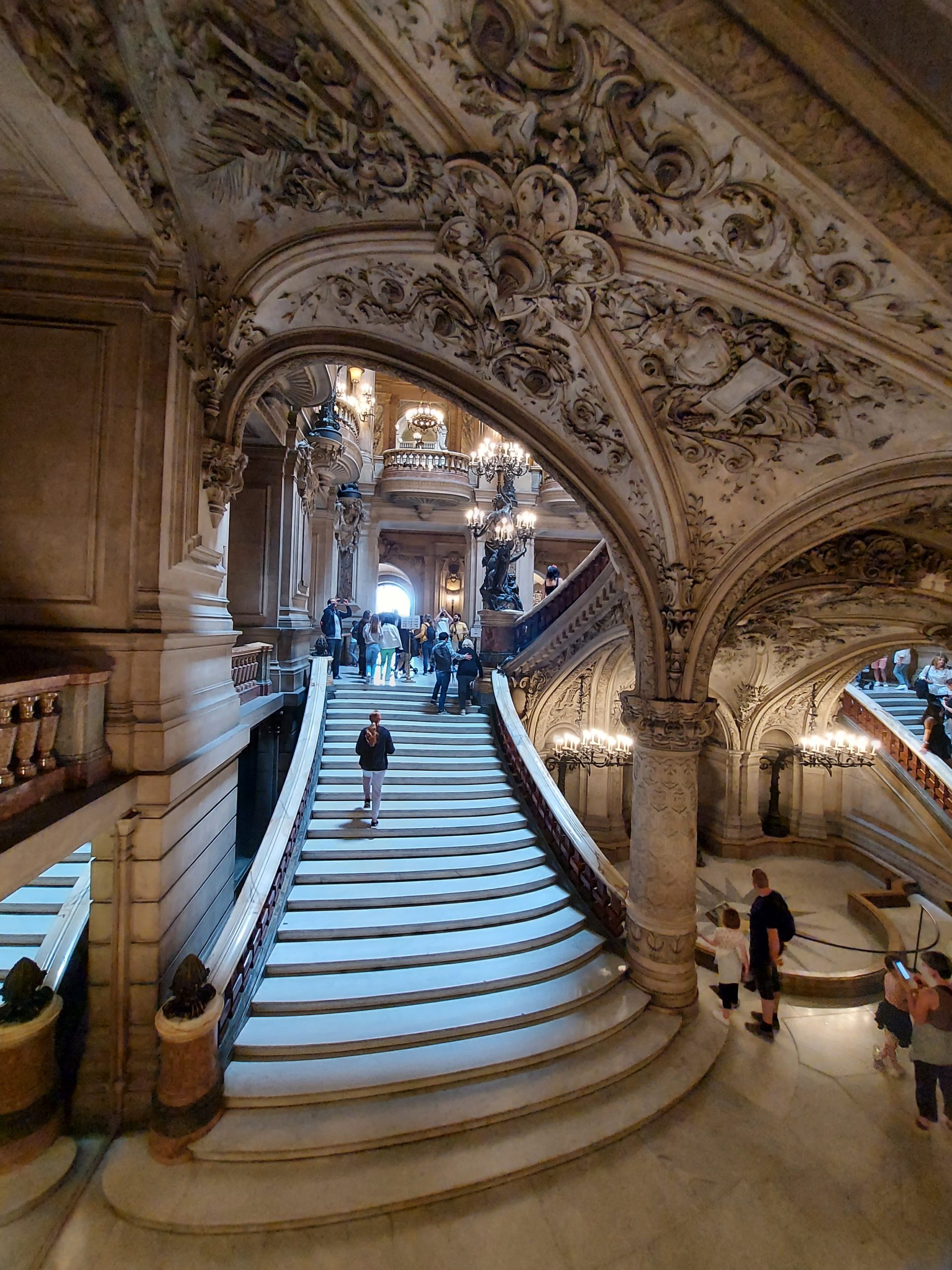
From both sides of the “Bassin de la Pythie” begin the arms of this spectacular double helix staircase. The use of white marble for its steps, the red of the balustrades and the green of the Swedish marble highlight its richness.
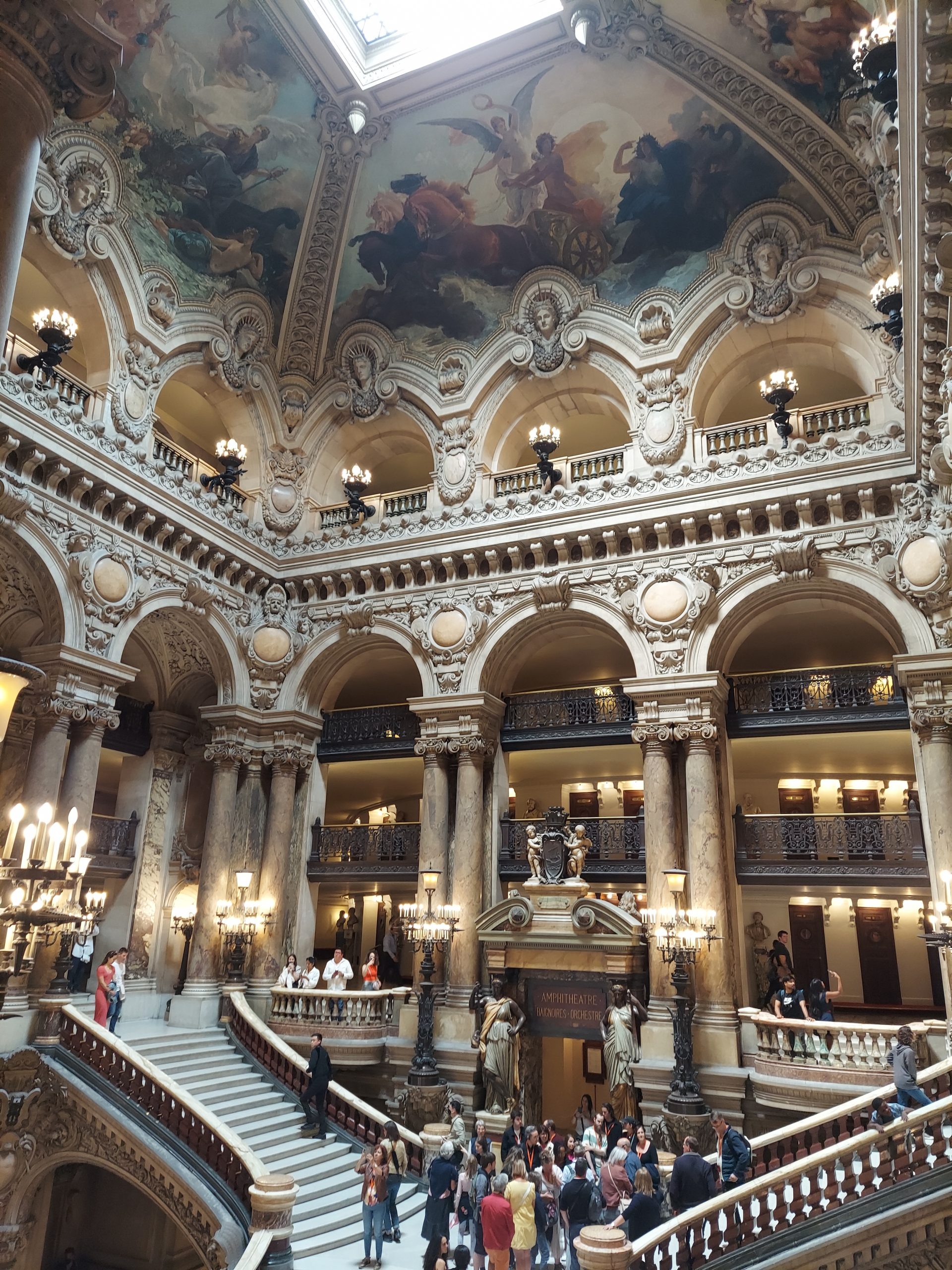
A curious fact is that the steps of this staircase are low and spaced for several reasons. The first, so that the ladies could climb the stairs more easily with their dresses so fitted and opulent. In this manner, the journey was lengthened enough to accomplish the objective, to be seen. It could take up to an hour to reach the stage.
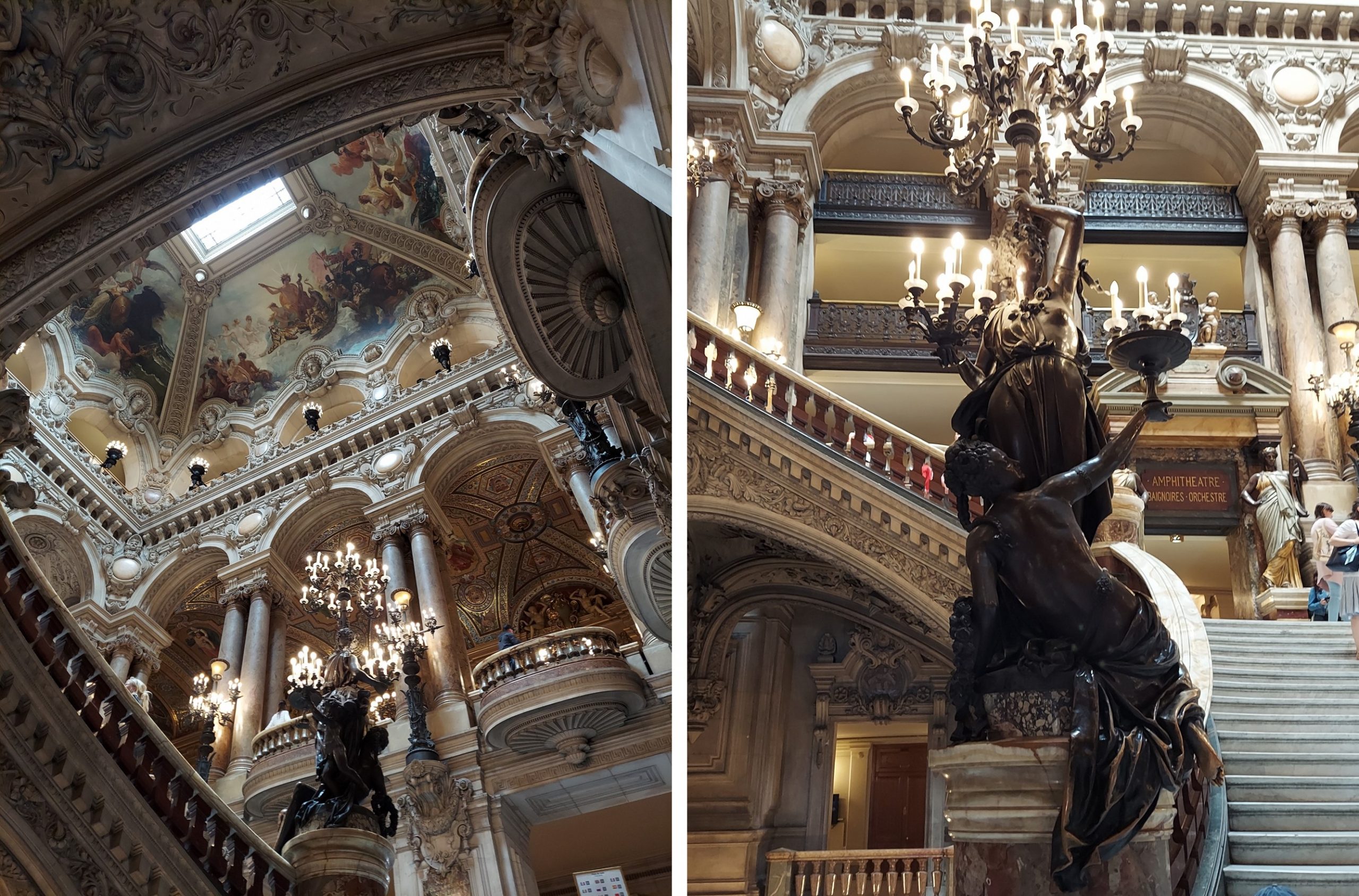
On the way up, a series of magnificently carved bronze statues can be seen. The ceiling of this grand stairwell is a true masterpiece. It is composed of four paintings and none of these are painted on the vault, rather on canvas adhered to the surface.
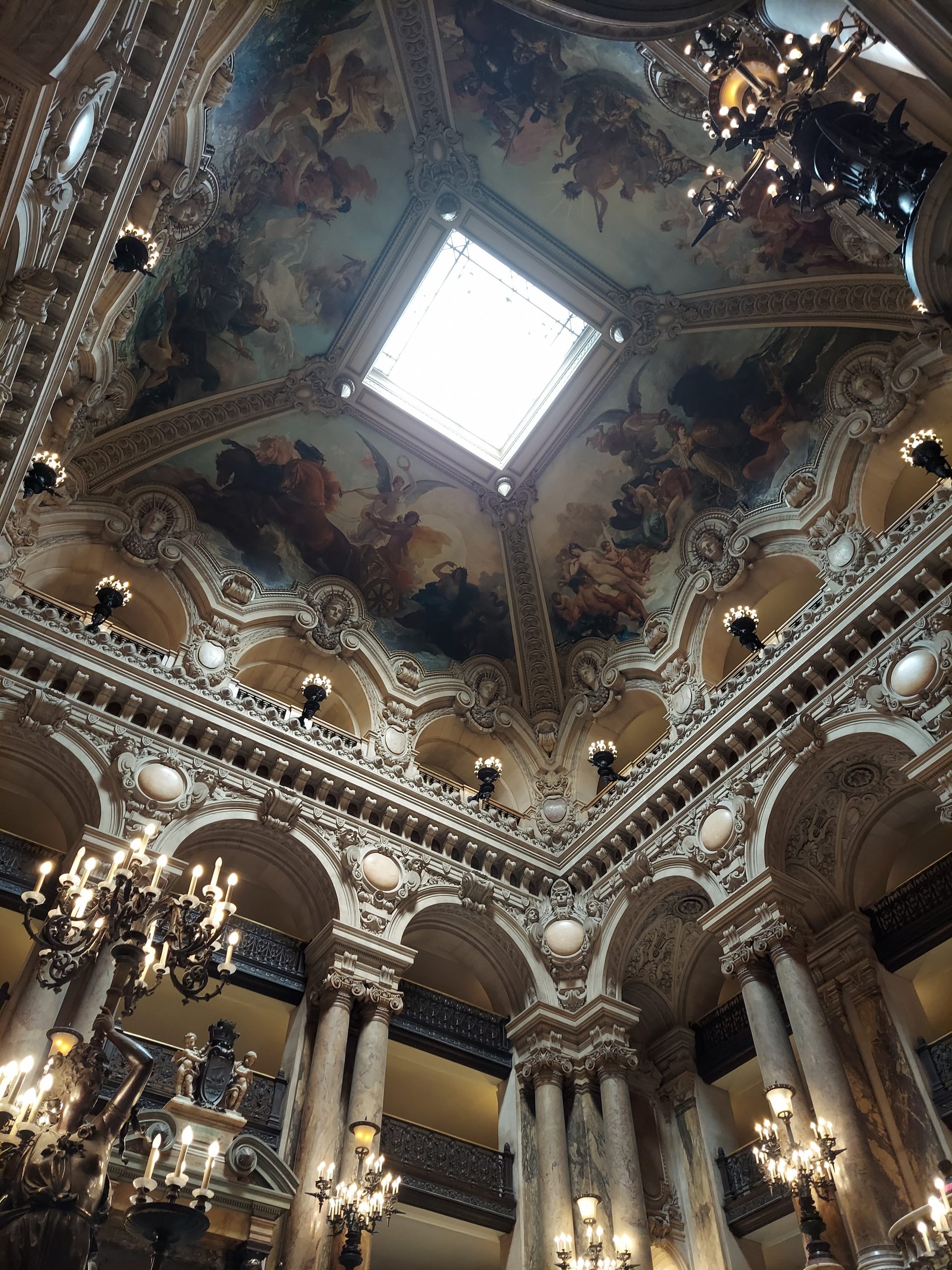
The works on the vault of the stairs are “The Triumph of Apollo”, “Minerva fighting brute force before the assembled Olympus”, “The charm of music” and “The city of Paris receiving the plan of the new Opera”. All of them are the work of Isidore Pils completed by his pupil George Clairin.
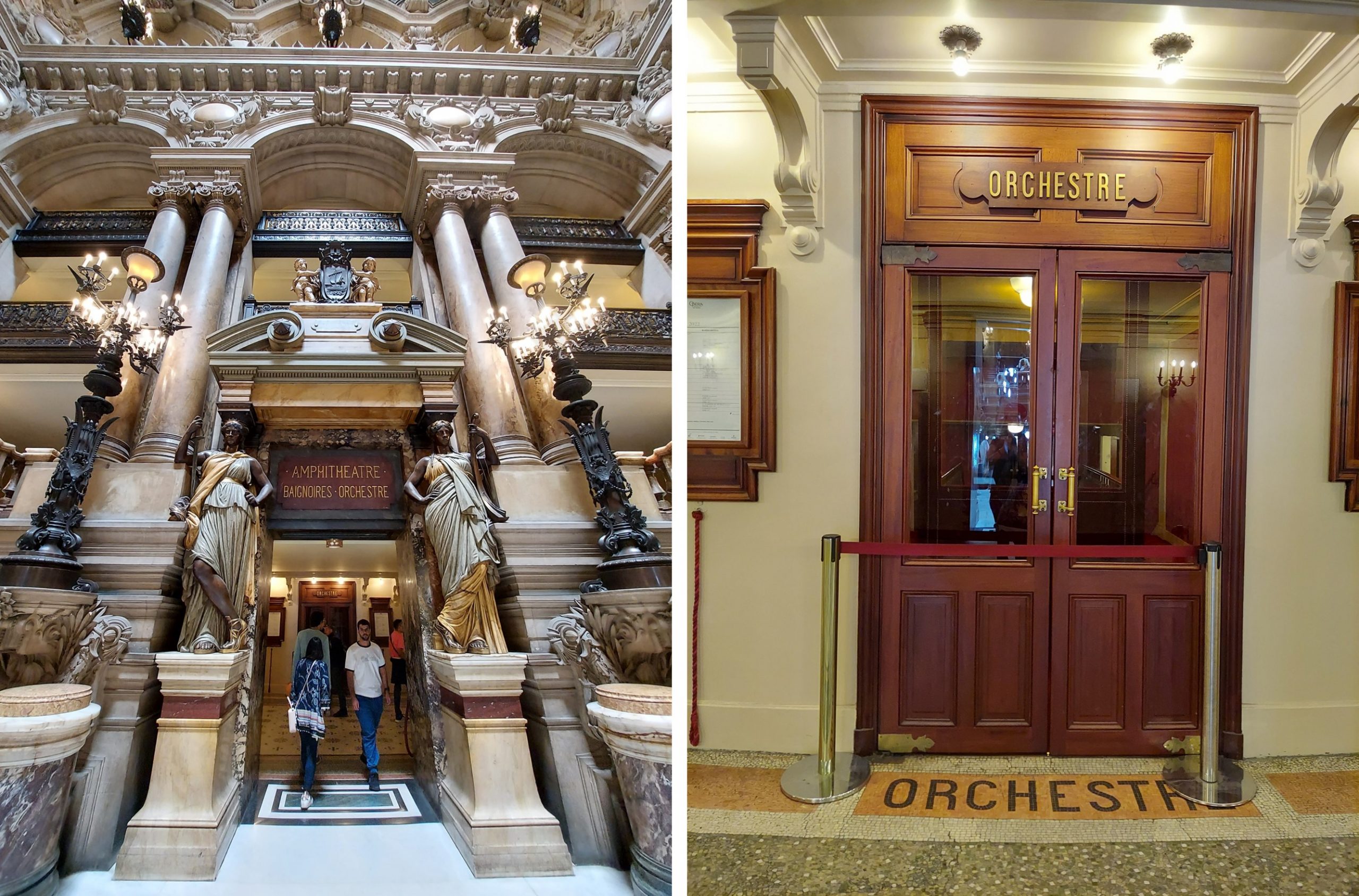
At the last step of the staircase is the door that allows the passage to the orchestra. Guarding the entrance, on either side of it, are the figures of the “Tragedy” on the right, holding a sword and the “Comedy” on the left holding a harp (reversed when facing inward). Above the gateway, there are two children resting on the coat of arms of Paris.
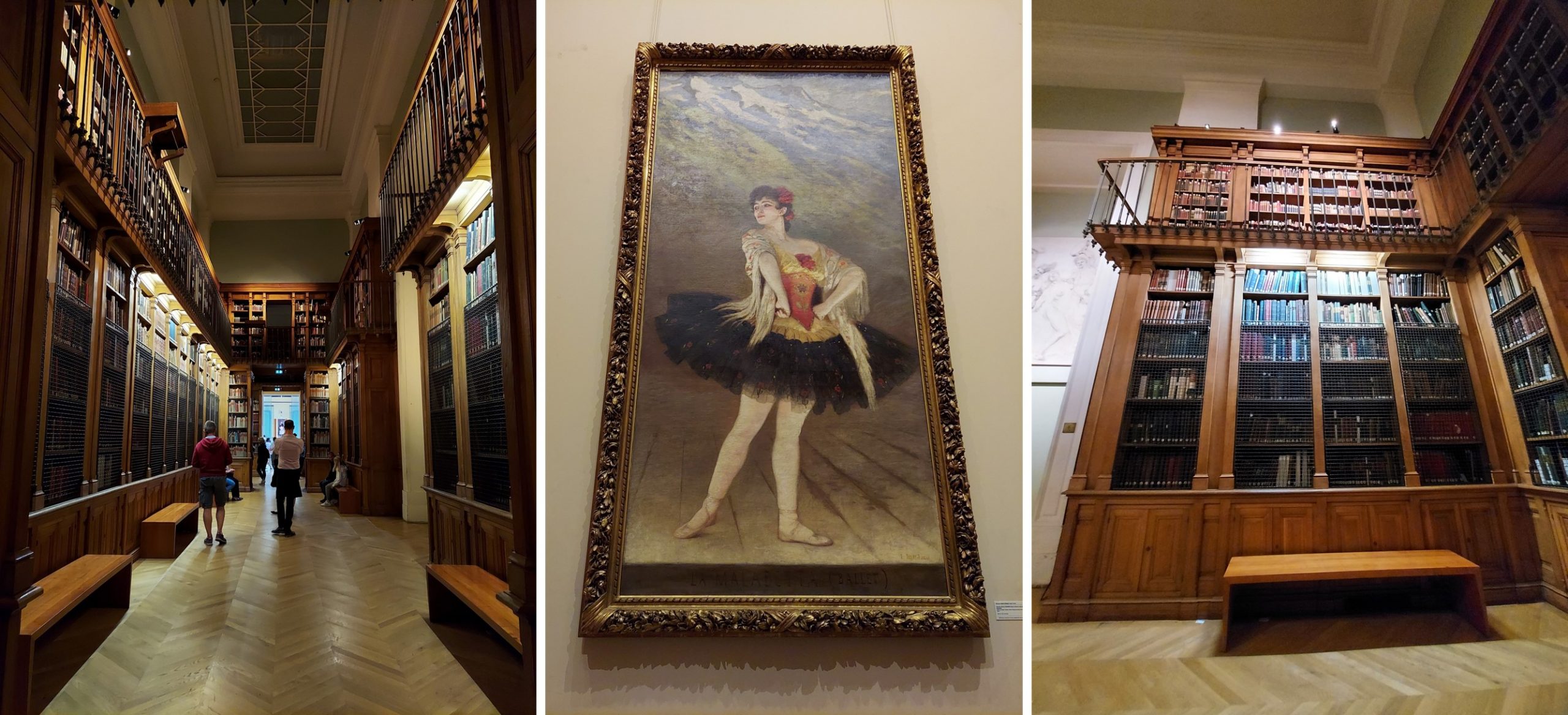
The “Palais Garnier” houses the Opera Museum Library, containing works of incalculable value. Since 1935, it has been one of the sites of the National Library of France. It was created in 1866 in order to ensure the preservation of the documents held by the Opera since 1669, including: musical testimonies and archives of the activity of the Opera, the “Opéra Comique” and other documents of the lyric theater, dance and circus.
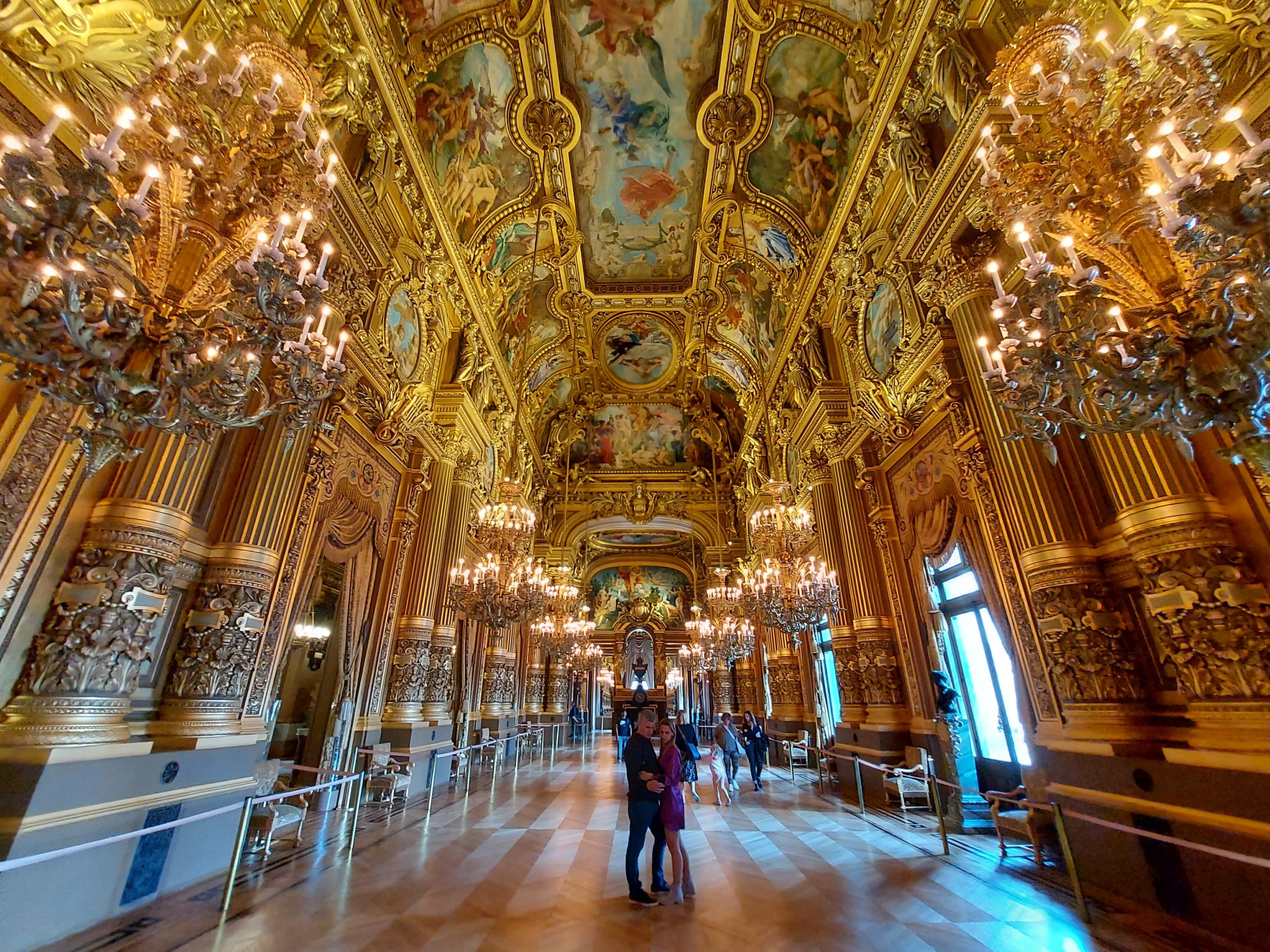
Another dazzling space is the Great Hall or “Le Grand Foyer”. Garnier conceived it as a place for spectators to stroll during intermission. In this gallery, there is an abundance of sculptures, gilding, paintings and chandeliers. It seems that Garnier was inspired by the castle galleries of the time.
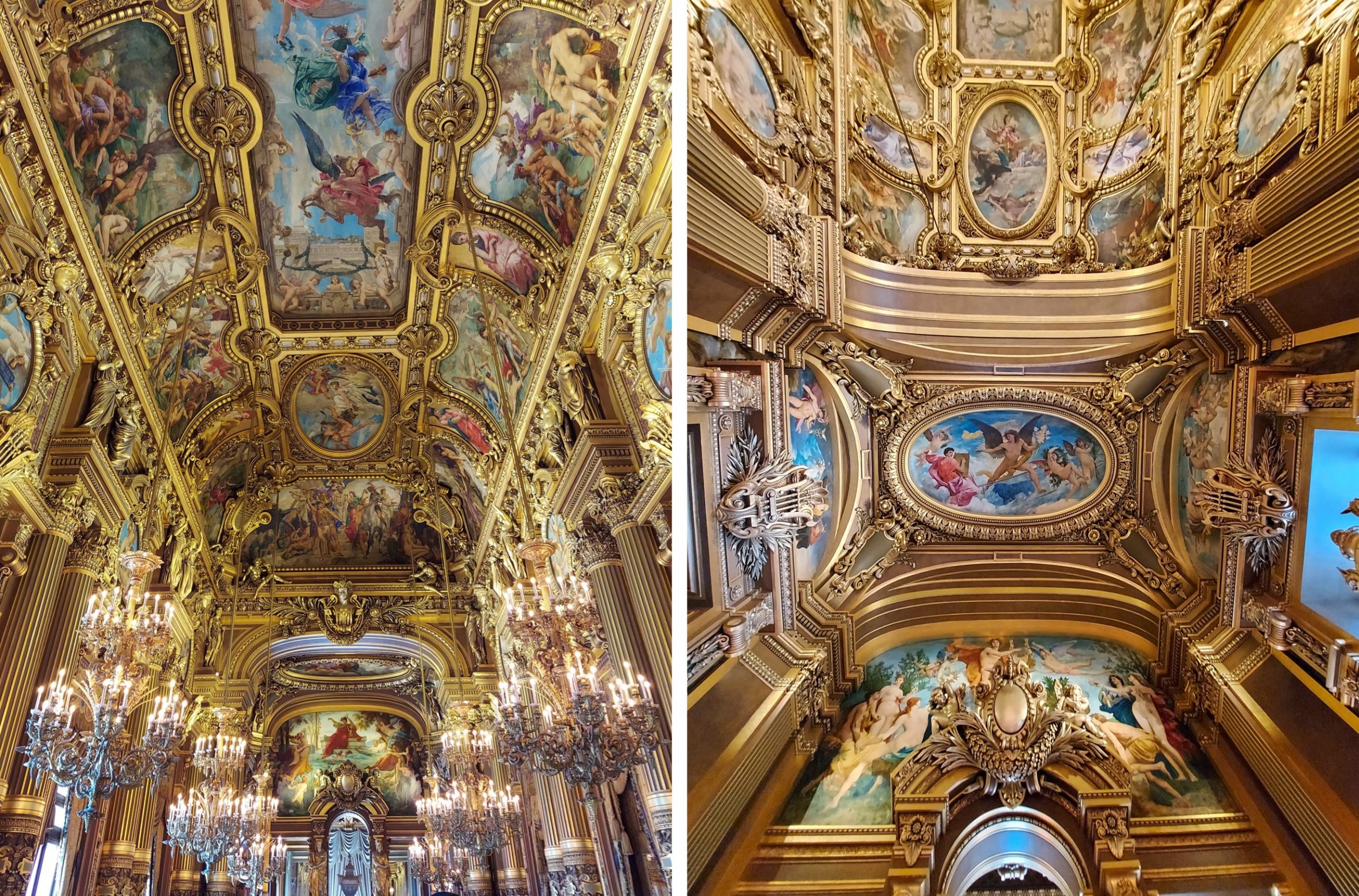
The Great Hall is lit by ten chandeliers and the richly painted and decorated ceilings are the work of Paul Baudry. This French painter was one of the most famous representatives of academicism during the Second Empire.
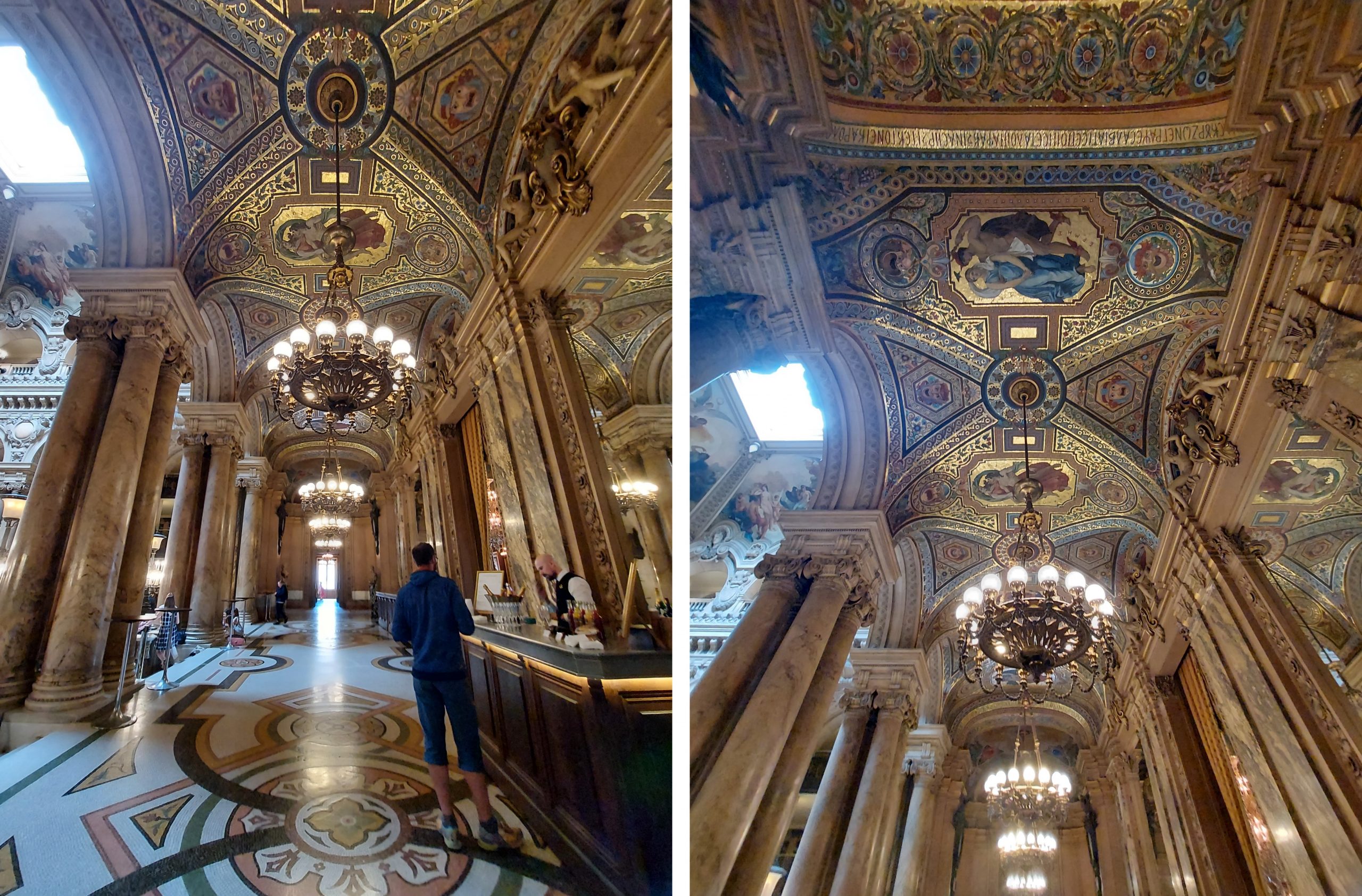
The Avant Foyer or “Foyer des Mosaics” is another magnificent space that exhibits the Palais Garnier in Paris. From the mosaics seen on its floor, to its richly decorated ceilings with mural paintings and gold leaf details, its magnificent columns and moldings convey an ostentation that is hard to beat. Definitely, the “foyers” or lobbies in which the spectators strolled during the intermissions, fulfill their function very well.
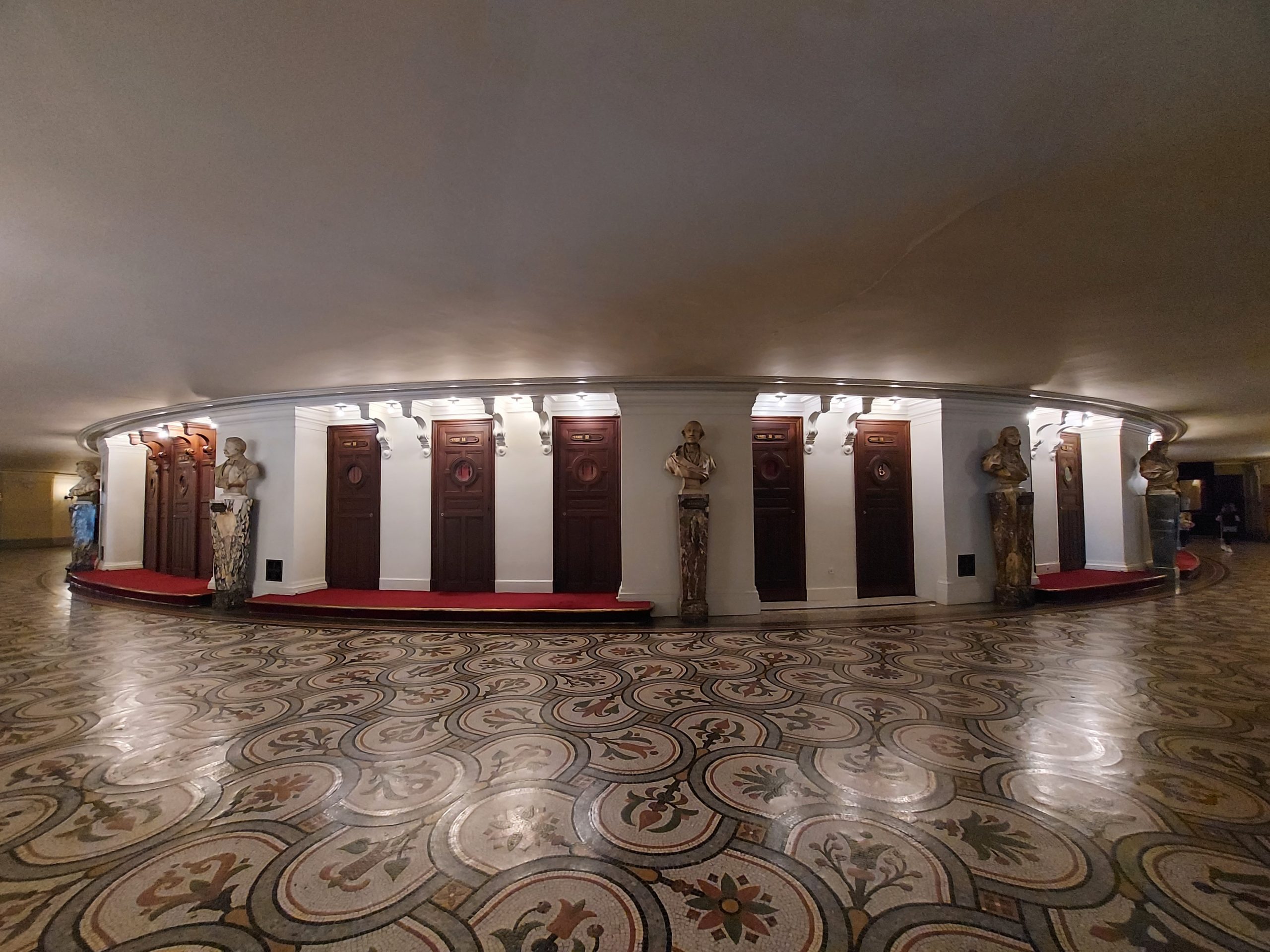
We present the exterior view of the performance hall from the top floor of the Palais Garnier. Although we were unable to enter, the hall is decorated in shades of red and gold, and illuminated by a huge crystal chandelier. It is a small hall compared to the size of the building and has 1,900 red velvet seats.
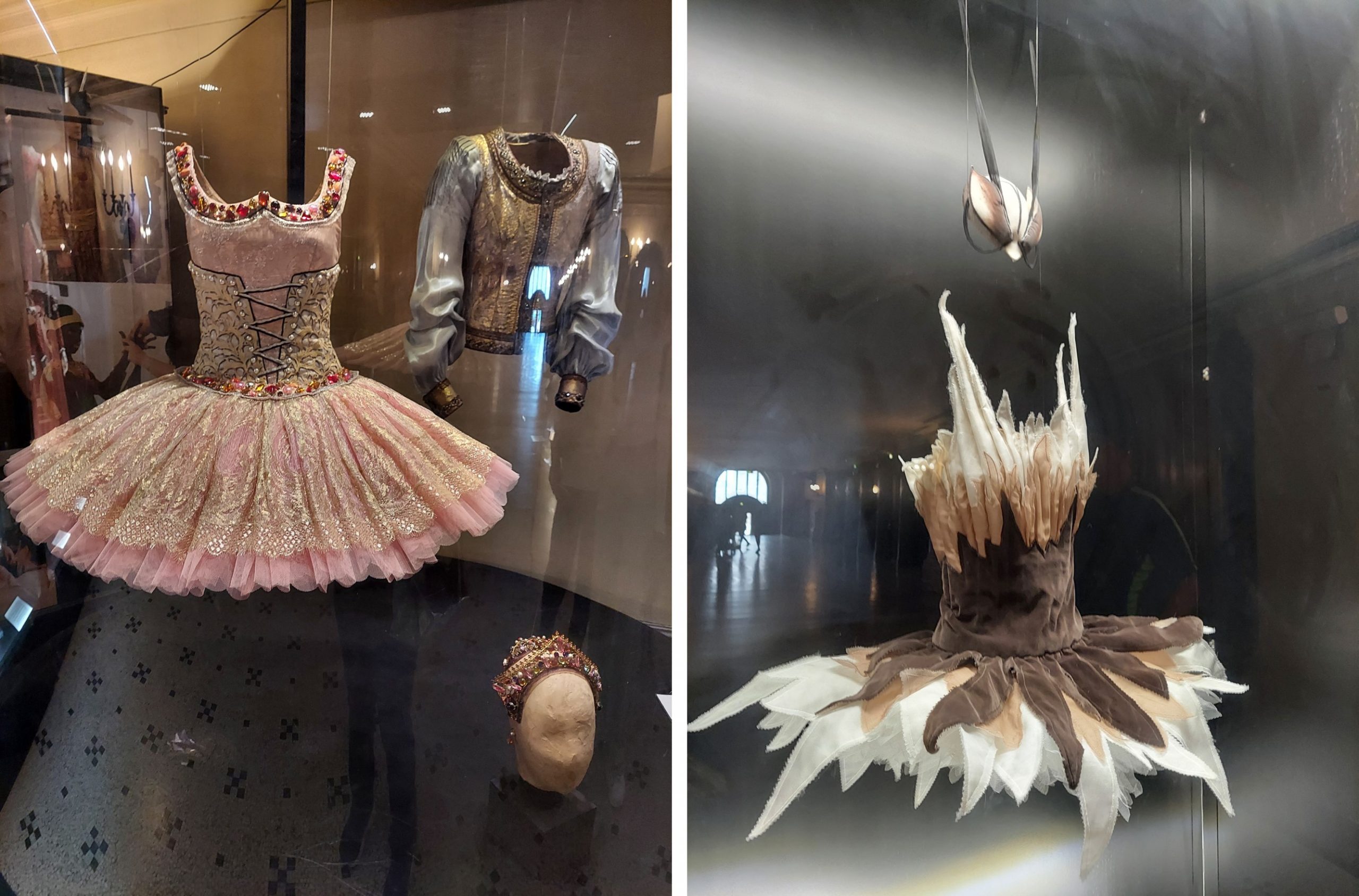
In ending, we show some of the costumes of important works exhibited at the Palais Garnier. The one on the right is the costume used in “Raymonda Act III”, (ballet in three acts), “Opéra National de Paris”, November 5, 1983. The second, from left, Piège de Lumière, “Un moustique” (a mosquito), “Opéra National de Paris”, April 8, 2010. Another curious fact is that the Palais Garnier served as inspiration for the creation of the famous play, the Phantom of the Opera.
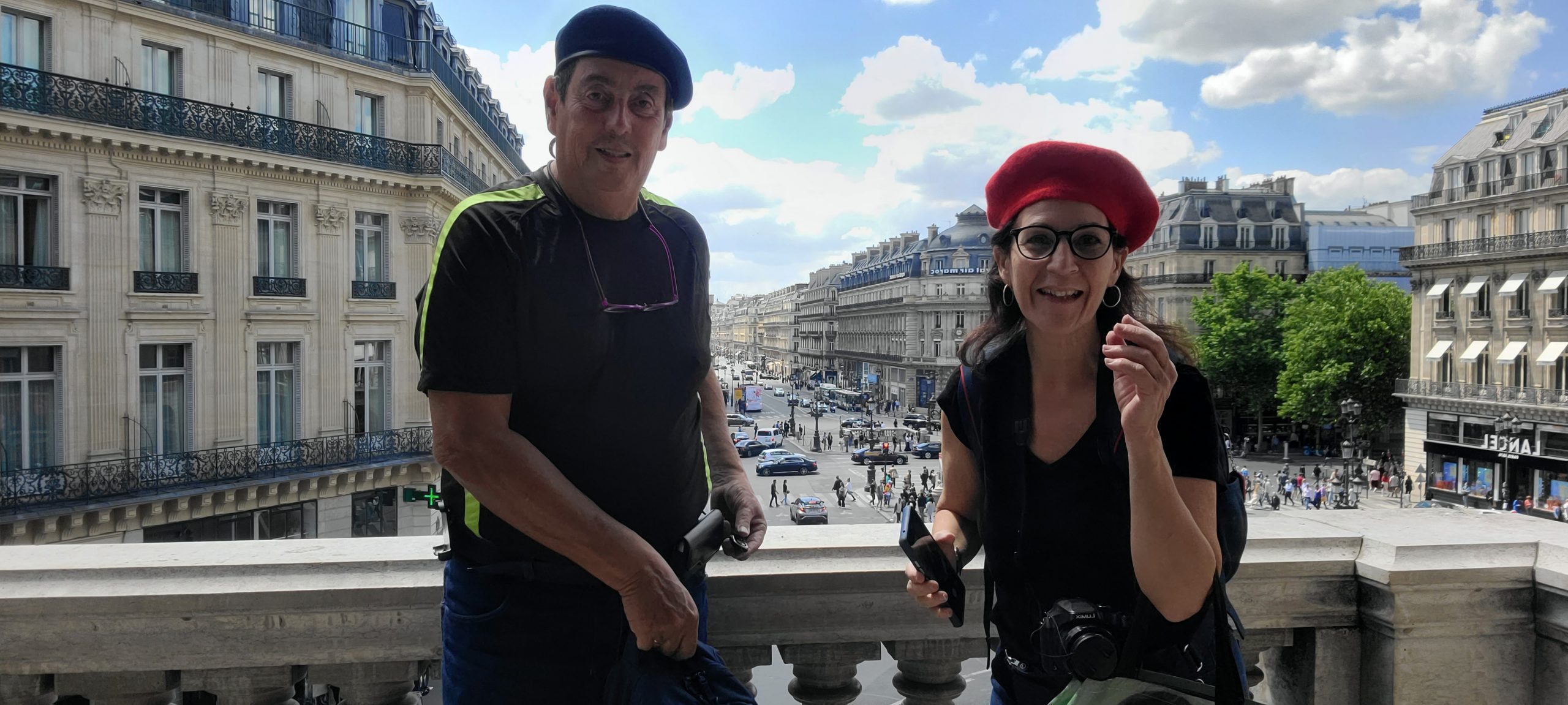
As always, we feel it is more convenient to buy tickets online in advance. The advantage, specifically at the Palais Garnier, is that there is no set time for the visit. You can arrive there with ticket in hand, on the chosen day during opening hours.
Resources:
https://es.wikipedia.org/wiki/%C3%93pera_Garnier
https://www.paris.es/opera-garnier
http://www.guiapracticaparis.com/opera-garnier.php
https://buendiatours.com/es/guias/paris/opera-garnier
https://es.france.fr/es/paris/articulo/el-palacio-garnier-opera-nacional-paris

